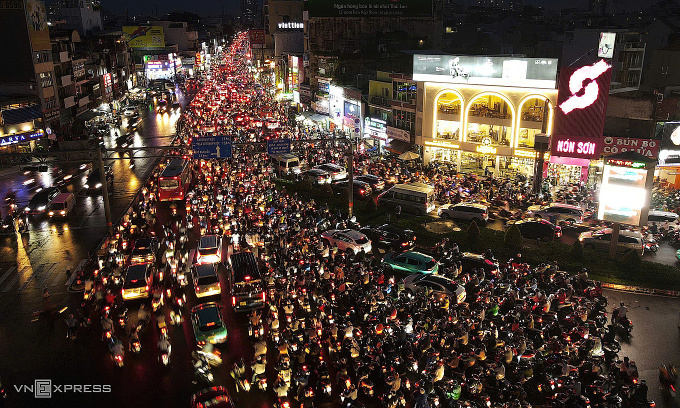Chronic gridlock grips HCMC’s busiest roads
Nguyen Tat Thanh Street, a major artery connecting the city center to Districts 4, 7, and Nha Be, is one of the most congested routes.
According to the Department of Transport, this road witnessed 811 traffic jams in the first nine months of this year—nearly as many as the 978 incidents recorded in all of 2023. This averages over two traffic jams per day, making it the city’s most congested area.
Traffic congestion on Nguyen Tat Thanh Street in HCMC’s District 4, Oct. 2024. Photo by Read/Ha Giang |
Stretching two kilometers from Khanh Hoi Bridge to Tan Thuan Bridge in District 4, Nguyen Tat Thanh Road has four lanes and a width of 14 meters. One side is densely lined with residential areas, schools, and businesses, while the other borders Saigon Port. As the main route linking District 1 to southern HCMC, heavy traffic on feeder roads like Hoang Dieu and Ton Dan during peak hours exacerbates the congestion.
More than a decade ago, the city planned to widen Nguyen Tat Thanh Street to 30 meters. However, in 2015, a revised plan proposed a width of 37 to 46 meters, depending on the section. The expansion aimed to reduce the impact on residential areas by focusing outward on the Saigon Port side, which would require additional land acquisition. While the city approved the proposal, delays in the Nha Rong – Khanh Hoi complex project, located within the Saigon Port area, led to land boundary issues and stalled road expansion due to lack of funding.
Operating at 140% capacity, even minor incidents cause gridlock on Nguyen Tat Thanh Street. Various measures such as restricting large trucks, banning parking, and closing medians during peak hours have been implemented but have proven insufficient in easing traffic.
 |
Traffic jam on Xo Viet Nghe Tinh street near Hang Xanh intersection in Binh Thanh District on Oct. 8, 2024. Photo by Read/Thanh Tung |
About five kilometers away, Xo Viet Nghe Tinh Street near the Hang Xanh intersection also faces severe traffic jams. This road connects the city center with National Highway 13 and Pham Van Dong Boulevard, serving as the northeastern gateway.
The worst congestion occurs on the stretch between Hang Xanh intersection and the Martyrs’ Memorial intersection, where several major roads converge. In the first nine months of this year, 615 traffic jams were reported on this section alone.
The area experiences high traffic volumes from workers leaving the city and students from nearby universities such as HCMC University of Technology, University of Foreign Trade, and HCMC University of Transport.
An official from the Transport Department noted that “during peak hours, traffic density is extremely high, and incidents or adverse weather conditions like heavy rain only worsen the gridlock.”
Similarly, Truong Chinh Road, a critical artery in the northwest, is plagued by persistent congestion. The road connects Tan Phu and Tan Binh districts to Tan Son Nhat Airport and the city center. Congestion frequently occurs between Au Co and Tan Ky Tan Quy streets, spanning nearly 300 meters. In the first nine months of this year, 569 traffic jams were recorded in this area.
In addition to these hotspots, HCMC has 20 other congestion-prone areas, primarily concentrated on major roads, gateways, and intersections. Some problem areas, like the An Phu intersection and Nguyen Thi Dinh Street near Cat Lai Port in Thu Duc City, have seen little to no improvement over the years.
Do Ngoc Hai, head of the city’s traffic infrastructure management department, stated that the rapid increase in vehicle numbers is putting immense pressure on the city’s infrastructure.
With the rainy season underway and students returning to school after the summer break, congestion has worsened in several areas. Contributing factors include road users’ lack of awareness, encroachment on roadsides, and construction barriers, he added.
While waiting for major infrastructure projects to progress, the city is focusing on upgrading existing roads and employing technology for traffic management through its smart traffic monitoring and control center.
“The transport sector is also providing traffic information via websites, apps, and 73 electronic boards to help citizens choose suitable routes and avoid congested areas,” said Hai.
 |
Traffic jam on Truong Chinh street near Tan Ky Tan Quy Street. Photo by Read/Quynh Tran |
To address specific congestion hotspots, the Department of Transport has proposed prioritizing several key projects through 2030, including widening Xo Viet Nghe Tinh and Dinh Bo Linh streets.
HCMC currently manages over 9.4 million vehicles, including more than 8.4 million motorcycles and nearly one million cars. Compared to 15 years ago, the number of vehicles in the city has increased by over five million, excluding those from other provinces.
Personal car registrations have risen by 7% in the first nine months of this year, outpacing the 4.5% increase in motorcycle registrations. However, the city’s road density remains at just 2.41 kilometers per square kilometer, far below the standard of 10 to 13 kilometers, leading to chronic road overload.


Comments are closed.